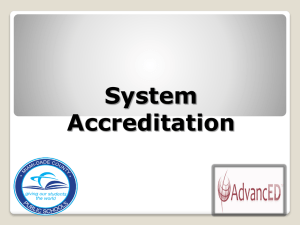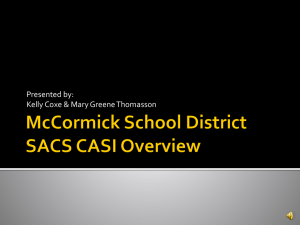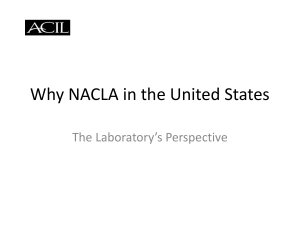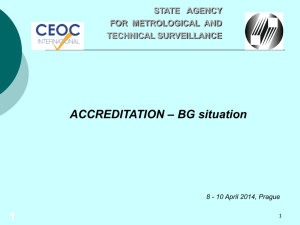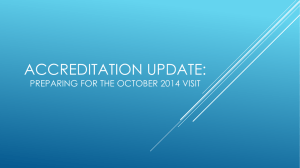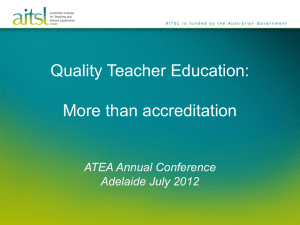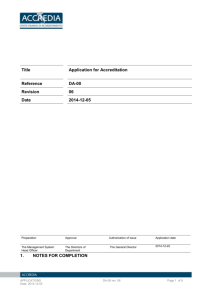Establishing a New Accreditation Program in the U.S.
advertisement
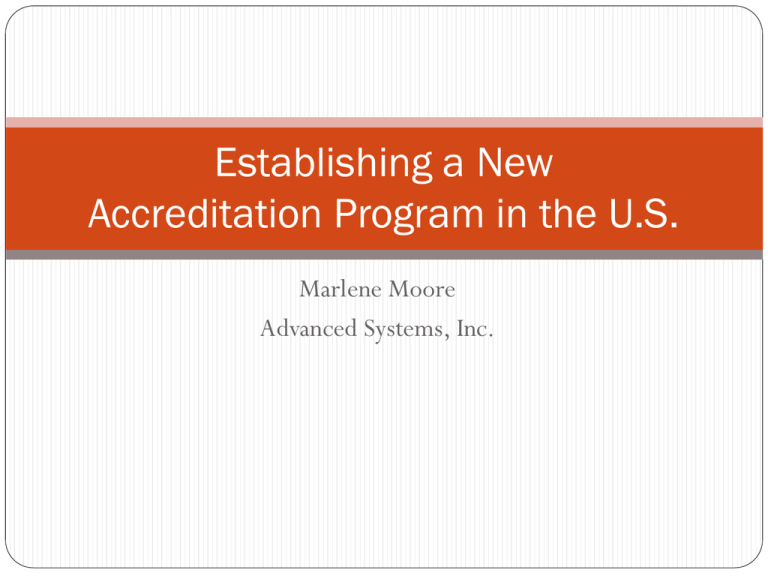
Establishing a New Accreditation Program in the U.S. Marlene Moore Advanced Systems, Inc. Outline Why have an accreditation program? Who do you involve? What does it take? How do you establish? Why have a Program? Users or Specifiers want competence to be assured Expect accreditation to assure competence Regulators want integrity, impartiality and competence Expect accreditation to assure confidence in data generated Law requires accreditation or assurance of conformance Conformity Assessment Body wants to demonstrate acceptable performance Expect accreditation to demonstrate to its clients that it is dedicated to the demonstration of competency, impartiality, integrity and acceptable performance to meet client needs Who do you involve? Everyone – even if no interest…at first…. Data users or specifiers in need of a program to ensure that the data is generated by a technically competent organization Standards, Criteria or Protocol developer to ensure information is understood by AB and CAB Accreditation Body (AB) to ensure program can be adopted by the AB and ensure interpretations are consistent Conformity Assessment Body (CAB) to ensure program can be implemented by the CAB and ensure interpretations are meaningful Lead organization to administer, handle appeals, and coordinate efforts of all parties What does it take? Opportunity CABs want to be accredited Organizations that want CABs to be accredited Cooperation All parties participating opening Transparency (No this is not the President talking) Understanding Process improvement Won’t be perfect first time out Demonstration of consistency of implementation How do you establish? Determine Criteria, Standards, Protocols – By whatever name Develop Program Goals Define Program Objectives Establish Operational Procedures Define Timeline for Program Establish and Implement Pilot Program Implement Program Criteria, Standards, Protocol By what ever name Founded on base ISO standard – e.g.; ISO/IEC 17025 Develop through consensus Best to ensure transparency and input into the criteria Scientifically Sound Ensures objectivity Must not be based on the following: Police the private sector based on hearsay That’s the way I want it – or That’s the way it has always been done so it is right Program Goals Implement a national program that is consistent Build recognition process among ABs to ensure uniform implementation of requirements Work with a lead organization to implement recognition Develop or Revise lead organization procedures to ensure national program Establish adoption and formal acceptance of the program Contracts, regulation, specification, etc. Develop government acceptance of program Provide input to standards or criteria developer for improvements Program Objectives Evaluation of ABs to meet, implement and understand the criteria, standards or protocols. Peer review process using documented procedures Lead organization objective review and assurance of consistent implementation by ABs Allow input from all parties into AB evaluation and lead organization process – Transparency of operations User, specifier and public support of program due to quality of the program’s implementation Ensure input into the criteria, standards by everyone including: CABs, ABs and Users Operational Procedures Definitions ISO/IEC 17000 Specifier or Regulator Resolve Conflicts Program Development Design Input Accreditation Requirements Resources Implementation Document Procedures Definition Accreditation Third-party attestation related to a conformity assessment body conveying formal demonstration of its competence to carry out specific conformity assessment tasks Accreditation Body Authoritative body that performs accreditation Conformity Assessment Body Body that performs conformity assessment services and that can be the object of accreditation. Definition (not ISO/IEC 17000) Assessment Process undertaken by an accreditation body to assess the competence of a conformity assessment body, based on particular standard(s) and/or other normative documents and for a defined scope of accreditation Note: Assessing the competence of a conformity assessment body (CAB) involves assessing the competence of the entire operations of the CAB, including the competence of the personnel, the validity of the conformity assessment methodology and the validity of the conformity assessment results. NOTE: This is not an Audit Design Input Identify impartiality and conflict of interest issues Define scope of accreditation Develop process steps to achieve accreditation Application Site visits Sampling process Define needs of users or specifiers Industry specific competency assessment criteria Determine limitations from ABs and CABs Contractual, financial and liability requirements Requirements Adopt process to define requirements Develop AB criteria for accreditation Determine status of CAB community to meet requirements Develop and approve procedures for operation Communication of the requirements Resources Identify assessors and technical experts Number and qualifications Training on operational procedures of AB Initial and on-going Identify advisory or stakeholder committee Other staff and operational needs to meet program needs Implement Program Announcement of launch of Pilot Applications received by ABs May include a preliminary review prior to acceptance ABs review applications for completeness ABs determine if application complete and within scope of program ABs process complete application following ISO/IEC 17011 Document review On-site assessment with witness of performance Non-conformances identified, if any Resolution of Non-conformances Implement Program Committee reviews information Committee makes decision on Accreditation or other process Letter sent to CAB Acceptance, Rejection or More Information For Pilot Announce first group of accredited CABs Continue program, if accepted by all parties Revise procedures and adopt to improve program Surveillance and Reassessment On-going review and improvements to program Timeline Define program cycle 2 years, 5 years or other – See ISO/IEC 17011 Surveillance years Witness assessments Time frame for visits (6 months, annual, etc.) Define timeframe for pilot Should never be less than 6 months. Give more time not less – There will be problems – do not try to rush the process!!! Pilot Program Start with Pilot Program Determines if procedures and processes work Define Timeframe or Trial Period Meet with all parties Consistent and constant communication needs Keep it simple Remember application information will not be perfect How do you select applications? When will applicants be accredited? When perfect?!? Revise Program elements after Pilot Implement Program Revise Based on input Based on changes to requirements Based on complaints, appeals, disputes Have process for emergency changes – Policy or Memos issued Improve Review procedures and administration processes as necessary Update Obtain input from all parties – on going Communicate Changes to all parties Newsletters, email announcements, formal letters, etc. Questions Thank You Marlene Moore Newark, Delaware mmoore!@advancedsys.com 302 368 1211
